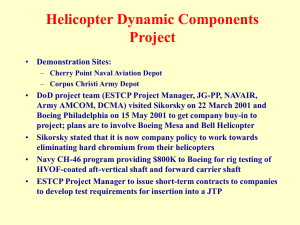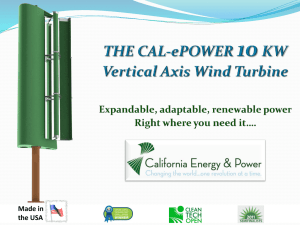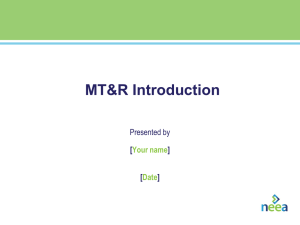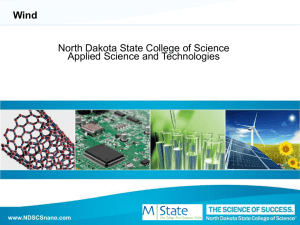FINAL EA R-Infra SUMMARY
advertisement
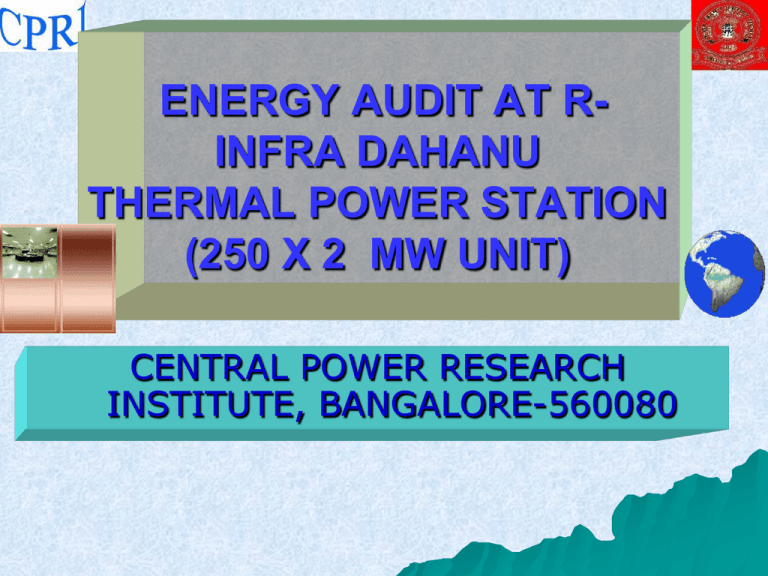
ENERGY AUDIT AT RINFRA DAHANU THERMAL POWER STATION (250 X 2 MW UNIT) CENTRAL POWER RESEARCH INSTITUTE, BANGALORE-560080 MERC CONTRACT TO CPRI INVESTIGATION INTO PERFORMANCE OF DTPS R-INF PERIOD: 2 MONTHS FROM 22.01.2010 TOR: RATING OF THE UNITS PERMISSIBLILITY OF MW OVERLOADING OF THE UNIT ABOVE THE MCR VALUE DE-RATING/UP-RATING OF THE UNITS FACT FINDING OF UNIT CAPACITY & HISTORY TESTS ON UNITS & CONSTRAINTS DESIGN CAPACITY/ RATING OF DTPS INSTALLED DURING BSES PERIOD 1995 TAKEN OVER BY R-INFRA IN 2003 NO MAJOR CHANGE IN HARDWARE SINCE IDENTICAL TO OVER 25 250 MW UNITS INSTALLED ALL OVER INDIA INCLUDING PARLI, PARAS & TATA TROMBAY. SAME DESIGN REPLICATED IN ALL UNITS. THEY ARE OF STAND 250 MW DESIGN OF BHEL PG TEST, INSTALLATION MANUALS, NAME PLATES, CAPACITY TESTS OF EQUIPMENT AND C & I INDICATE UNITS ARE OF 250 MW CAPACITY. Margins provided by OEM Continuous peak plant load duty (over and above the 100 % unit MCR rating) is denoted equipment wise as follows: Boilers: BMCR (boiler MCR) rating Turbines: VWO (valve wide open) rating Generators: MVA (apparent power) rating Generating transformers: MVA (apparent power) rating Margins over 250 MW DTPS units have operating margins of: 8 % steam flow in the boiler side (BMCR flow) 5 % power output on the turbine side (VWO flow) 16 % on the generator side (capability curve) 23 % on the generator transformer side. These margins are provided in all 250 BHEL supplied units including those at Paras Unit 3, Parli Unit 6 and Tata Trombay Unit 8 as elaborated in the text. MARGINS CAN BE FULLY USED CONTINUOUSLY PROVIDED PARAMETERS ARE NOT EXCEEDED. OEM HAS IMPOSED RESTRICTIONS ONLY ON OPERATING PARAMETERS OF INDIVIDUAL EQUIPMENT AND NOT ON MW MARGINS BOILER MARGINS Sl. No. Unit particulars-boiler Dahanu 250 MW Units 1 & 2 UNITS NCR BMCR MARGIN Design t/h 746.60 805 1.08 CE/BHEL t/h 736.20 810 1.10 CE/BHEL t/h 738.21 810 1.10 CE/BHEL t/h 736.20 810 1.10 CE/BHEL t/h 652 700 1.07 CE/BHEL 6 Chandrapur 210 MW Unit 3 t/h 652 700 1.07 CE/BHEL 7 Bhusawal 210 MW Unit 3 t/h 654 700 1.07 CE/BHEL t/h 652 700 1.07 CE/BHEL Khaperkheda 210 MW Unit No 4 t/h 624.23 690 1.11 CE/BHEL Chandrapur 500 MW Unit 7 t/h 1540 1670 1.08 CE/BHEL 1 2 3 4 5 8 9 10 Paras 250 MW Unit 3 Parli 250 MW Unit 6 Tata Trombay Unit 8 Nasik 210 MW Unit 5 Koradi 210 MW Unit 7 INSTALLATIONS at SL. Nos.5-10 are old Plant load (active power or MW) dependent and plant load independent parameters: Majority of the quality parameters like temperature, pressure (except for variable pressure operation), voltage, etc., are designed by the OEM to be nearly constant and first order load independent for the load range of 60 % UMCR to through maximum load and changes are only second order. However, the quantity parameters like flow, current, etc. are directly proportional to active power (MW) or plant load or machine loading. As energy efficiency increases these quantities decrease in magnitude for a given output. OEM DEFINITION OF: CONTINUOUS PEAK LIMITED TIME PEAK PARAMETERS Continuous peak parameter: purposefully set for achieving the maximum performance or output from the machine. Peak parameters for limited periods: time limits in s /min /h in one excursion as well as total time in the lifetime of the equipment. Occurs because of system operational transients or constraints or faults or system mismatch. Sl. No. 1 2 3 4 5 Partic ulars at 100 % BMCR condit ions Units Dahan u 250 MW Paras 250 MW Parli 250 MW Unit 6 Nasik 210 MW Unit 5 Chandr apur 210 MW Unit 3 Bhusawa l 210 MW Unit 3 Koradi 210 MW Unit 7 Khaper kheda 210 MW Unit No 4 Chandra pur 500 MW Unit 7 Desig n coal GCV kcal/ kg 3700 3400 3400 5000 4445 5100 5000 3500 3500 Annua l avera ge GCV kcal/ kg 3966 3652 3608 3422 3170 3235 3642 3354 3170 Total heat to boiler Mcal /h 599. 4 611.7 527.34 536 533.4 531.42 527.5 515.5 5 1215.9 Total fuel quanti ty t/h 162 179.9 155.1 107.2 120 104.2 105.5 147.3 347.4 Restri ction on BMCR to GCV % less No No No Yes No Yes Yes No No Variation of Steaming rate with boiler efficiency at constant coal consumption and constant GCV Steaming rate, t/h 810 800 790 780 770 760 750 740 80 82 84 86 88 Boiler efficiency, % SIMULATED FROM ACTUAL DATA 90 Coal consumption, t/h Variation of coal consumption with boiler efficiency at a constant boiler steaming rate and constant GCV 164 162 160 158 156 154 152 150 80 82 84 86 88 Boiler efficiency, % SIMULATED FROM ACTUAL DATA 90 Dependence of unit loading (MW) on the coal quality 280 y = -4E-05x 2 + 0.351x - 465.57 R2 = 0.7627 Unit load (MW) 270 260 250 240 230 3300 3500 3700 3900 4100 4300 Coal GCV (kcal/kg) SIMULATED FROM ACTUAL DATA 4500 Heat loading rate (Million kcal/h) in the boiler Heat loading rate (106 kcal/h) 640 620 600 design 580 Operating 560 Linear (design) 540 Linear (Operating) 520 500 480 235 240 245 250 255 260 265 270 Plant load (MW) SIMULATED FROM ACTUAL DATA 275 TURBINE MARGINS Sl. Unit particularsNo. Steam turbine UNITS TMC R Dahanu 250 MW Units 1 & 2 MW MARGIN Design 250 262.82 1.05 Seimens MW 250 264.78 1.06 Seimens MW 250 264.78 1.06 Seimens MW 250 264.78 1.06 Seimens MW 210 213.30 1.02 Russian 6 Chandrapur 210 MW Unit 3 MW 210 215.80 1.03 Russian 7 Bhusawal 210 MW Unit 3 MW 210 215.00 1.02 Russian MW 210 215.80 1.03 Russian Khaperkheda 210 MW Unit No 4 MW 210 221.70 1.06 Seimens Chandrapur 500 MW Unit 7 MW 500 1.05 Siemens 1 2 3 4 5 8 9 10 Paras 250 MW Unit 3 Parli 250 MW Unit 6 Tata Trombay Unit 8 Nasik 210 MW Unit 5 Koradi 210 MW Unit 7 VWO 524.40 TURBINE MARGINS Sl. No. Unit particulars - Steam turbine UNITS TMC R VWO MARGIN Hitachi 1 MW 210 222.00 1.06 MW 210 222.00 1.06 MW 210 221.70 1.06 MW 210 215.60 1.03 Mitsubishi 2 Siemens 3 Russian 4 Steam input to turbine, t/h Variation of steam input with turbine heat rate at constant power output VWO: 800 t/h 765 760 755 750 745 740 735 1920 1940 1960 1980 Turbine heat rate, kcal/kWh SIMULATED FROM ACTUAL DATA 2000 Variation of power output with turbine heat rate at constant steam input to turbine Power output, MW VWO: 800 t/h 264 262 260 258 256 254 1920 1940 1960 1980 Turbine heat rate, kcal/kWh SIMULATED FROM ACTUAL DATA 2000 TURBINES DTPS has be able to maintain good MW load ability on the machine within the OEM margins and without exceeding any OEM parameter limits by: Maintaining high turbine efficiency (turbine heat rate deviates from design by only 4.4 kcal/kWh) Strictly maintaining water quality parameters as per OEM guidelines Minimizing auxiliary stack, vent and gland sealing steam requirements in the turbine. Sl. No. MW at pf = 0.85 MARGIN MW at pf=0.85 pf=0.99 to 0.99 Unit particularsGenerator MVA rating Dahanu 250 MW Units 1 & 2 294.0 250 291.18 1.16 294.1 250 291.18 1.16 294.1 250 291.18 1.16 294.1 250 291.18 1.16 247.0 210 244.59 1.16 6 Chandrapur 210 MW Unit 3 247.0 210 244.59 1.16 7 Bhusawal 210 MW Unit 3 247.0 210 244.59 1.16 247.0 210 244.59 1.16 Khaperkheda 210 MW Unit No 4 247.0 210 244.59 1.16 Chandrapur 500 MW Unit 7 588.0 500 582.35 1.16 1 2 3 4 5 8 9 10 Paras 250 MW Unit 3 Parli 250 MW Unit 6 Tata Trombay Unit 8 Nasik 210 MW Unit 5 Koradi 210 MW Unit 7 TESTS ON UNITS Maximum load- 265.5 MW: 2292.7kcal/kWh 100 % UMCR- 252 MW: 2299.13 kcal/kWh F-GRADE LOAD- 2326.2 kcal/kWh MAXIMUM LOAD REACHED WAS 240 MW Design: 2230.60 kcal/kWh Achieved: 2293 kcal/kWh EVEN AT 268 MW NO PARAMETER HAS EXCEEDED OEM LIMITS ; DTPS CONTROL SET POINTS ARE BELOW OEM LIMITS Loadability Combining all the margins provided by the OEM, R-Infra has been able to load the unit to 268 MW against the design value of 250 MW. Maintaining this load is not harming the life of the unit as the DTPS has ensured that all parameters are kept within OEM limits. High loadability is made possible by high energy efficiency or low unit heat rate which enables the parameters not to exceed their limits. OEM MANUALS DO NOT SPECIFIC ANY UPPER LIMITS ON MW LOADING OR MW OVERLOADING ABOVE 100 % UMCR RATING, OEM MANUAL SPECIFIES CONTINUOUS AND LIMITED TIME LIMITS ON OPERATING PARAMETERS OF B, T,G,GT, ETC. Remaining life Units 1 & 2 have been commissioned in Jan and March 1995 and have completed 15 years of service and nearly 1,20,000 operating hours. Acceleration of life expenditure takes place due to parameter excursions into the limitedtime-overload-regime for long periods, due to frequent cyclic loading, due to frequent transients with high ramping rates. Scrutiny of operation and parameters indicates that the DTPS has avoided operation in these life limiting regimes thereby preserving the longevity of their assets. The cyclic operations are far lower than their design values. We are here Remaining Life (h, years) Ө Ө > 45˚ poor Ө=45˚ Normal Real time years <45 ˚ Good Remaining life Considering a total engineering life of 35 years of service or 3,00,000 operating hours the physical (actual) life expenditure of both units is expected to be 40 %. Except for generator, where the life expenditure is 50 % (remaining life= 50 % or 14 years), the remaining life of other components matches roughly with the physical life expenditure. This indicates that acceleration of life has not taken place. The low degradation rate coupled with the high loading on the plant also leads to the conclusion that the equipment are healthy and factors in the nature of non-repairable damage are not present. UNHEALTHY EQUIPMENT CANNOT BE LOADED AT ALL Degradation The CPRI test TG HR is showing a degradation rate of 0.13 %/year. The degradation is 2.0 % of the DHR LOW LEVEL OF DEGRADATION INDICATES THAT THE EQUIPMENT ARE HEALTHY AND NO NEGATIVE EFFECTS OF MW LOADING BEYOND 100 % UMCR Up-rating/de-rating The maximum load on Unit 1 was 268.7 MW and on Unit 2 was 266.0 MW in 2009 & in 2010. Uprating or de-rating of the unit has been studied and it is concluded that the unit capacity is 250 MW and the present maximum plant loading of 268 MW is sustainable only because of high boiler, turbine and generator efficiency; and external factors like coal quality being 600 kcal/kg higher and high power factor of 0.99. The sustainability may not be long lasting. The PG test by OEM is for 250 MW, these units are identical to several 250 MW units, grid code 2005 stipulates a margin over the 100 % UMCR rating. Considering these facts it is concluded that the up-rating of 250 MW to 260 or 265 MW may not be sustainable in terms of availability as well as loadability in the future. CONCLUSIONS SCRUTINY OF RECORDS INDICATES UNIT CAPACITY IS 250 MW IDENTIAL TO OTHER 250 MW UNITS SUPPLIED BY BHEL. OEM MARGINS IN BOILER, TURBINE, GENERATOR AND GENERATOR TR HAVE BEEN FULLY MADE USE OF TO ACHIEVE LOADABILITY OF 268 MW WELL WITHIN OEM PARAMTER LIMITS. OEM MARGINS CAN BE FULLY USED CONTINUOUSLY PROVIDED PARAMETERS ARE NOT EXCEEDED. OEM HAS IMPOSED RESTRICTIONS ONLY ON OPERATING PARAMETERS OF INDIVIDUAL EQUIPMENT AND NOT ON MW MARGINS. OEM PARAMTERS ARE NOT EXCEEDED BY DTPS. TESTS INDICATE ANNUAL UHR OF: 265.5 MW - 2293 kcal/kWh 100 % UMCR- 252 MW: 2299.13 kcal/kWh F-GRADE LOAD- 2326.2 kcal/kWh MAXIMUM LOAD REACHED WAS 240 MW Design: 2230.60 kcal/kWh Achieved STATION DATA : 2293 kcal/kWh CONCLUSIONS UPRATING OF THE UNIT HAS BEEN STUDIED. SINCE THE UNIT IS OF 250 MW STANDARD DESIGN OF BHEL, THE MARGINS ARE BEING UTILIZED BY ENERGY EFFICIENCY IMPROVEMENTS, HIGHER GCV OF COAL AND HIGH POWER FACTOR. THESE CIRCUMSTANCES MAY NOT BE SUSTAINABLE ALL THROUGH THE LIFE OF THE UNIT. GENERATORS AND GTS ARE QUITE HEALTHY AND NORMAL. REMAINING LIFE IS ALSO GOOD. NO IMMEDIATE RISK FOR 16-20 khours AS PER THE RLA REPORTS OF ABB & ERDA. CONSIDERING THE CRITICALITY OF LOAD HANDLED BY DTPS AND CONSIDERING THAT THERE ARE NO SPARES WITH OTHER MEMBERS OF MAHARASHTRA GRID FOR 250 MW THESE CAN BE CONSIDERED.

